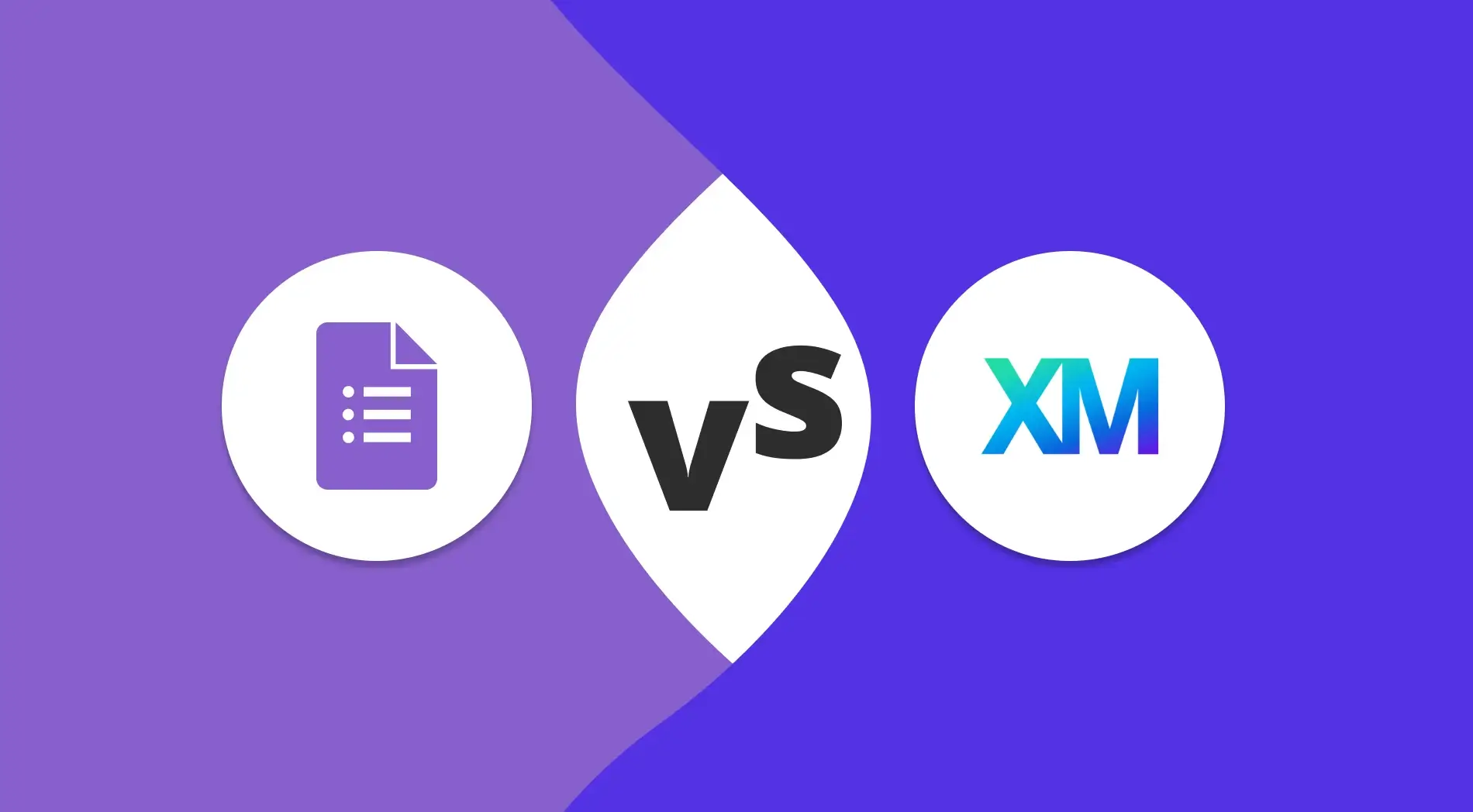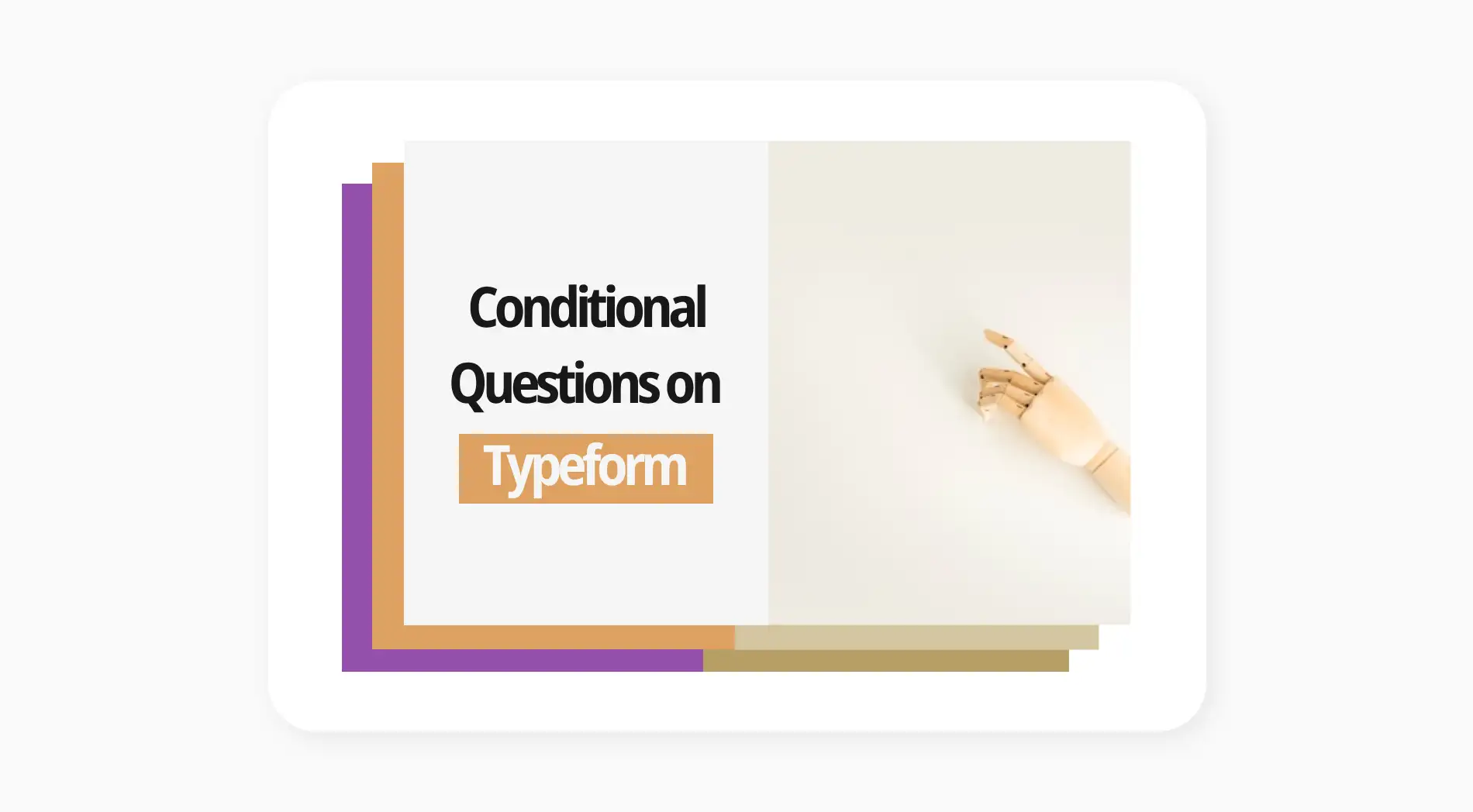Hoy en día, dirigir un negocio requiere una eficiente recopilación de datos, y los constructores de formularios en línea son de gran ayuda para esto y otros propósitos. Te permiten acceder a formularios desde cualquier lugar con conexión a internet, lo cual es esencial para operaciones multiubicación y remotas. Además de recopilar datos, los formularios bien construidos pueden ayudar con pedidos en línea, procesos de recursos humanos, e incluso organización de eventos.
El paso crítico es elegir la herramienta perfecta. Creemos que ya has intentado usar plataformas como Google Forms u otras opciones básicas para formularios en línea. Este artículo comparará dos aplicaciones populares para construir formularios, Google Forms y Qualtrics. Obtendrás información sobre sus características, lo que te ayudará a decidir cuál usar, o incluso podrías descubrir una gran alternativa después de leer.
Google Forms vs. Qualtrics a primera vista
Comenzaremos echando un vistazo a Google Forms y Qualtrics. Hay algunas características esenciales que tu constructor de formularios debería ofrecer, como una recopilación de datos fluida, una interfaz sencilla, y un control efectivo de envío de formularios. Profundizaremos en los detalles de estas aplicaciones más adelante. Por ahora, aquí tienes una descripción general de lo que son y cómo pueden beneficiar tus necesidades.
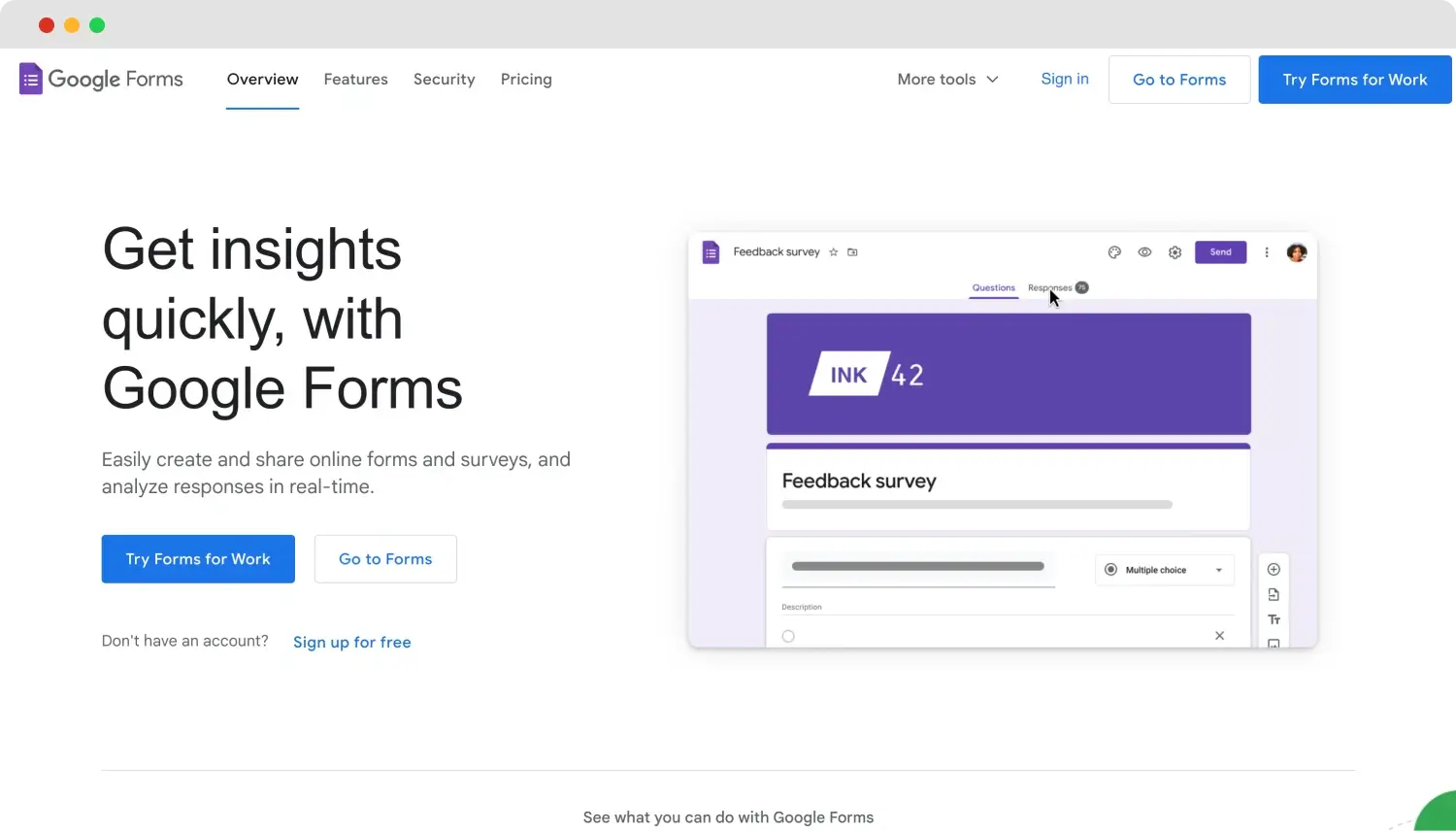
La página de inicio de Google Forms
Google Forms crea una plataforma en línea fácil de usar para recopilar datos a través de formularios personalizables. Al ser parte de Google Workspace, este servicio es accesible en cualquier dispositivo, lo que lo hace ideal para uso empresarial, educativo, y personal. Su asequibilidad hace que Google Forms sea ideal para pequeñas empresas, permitiéndoles crear formularios rápidamente, personalizar campos, y recopilar respuestas sin esfuerzo directamente en Google Sheets.
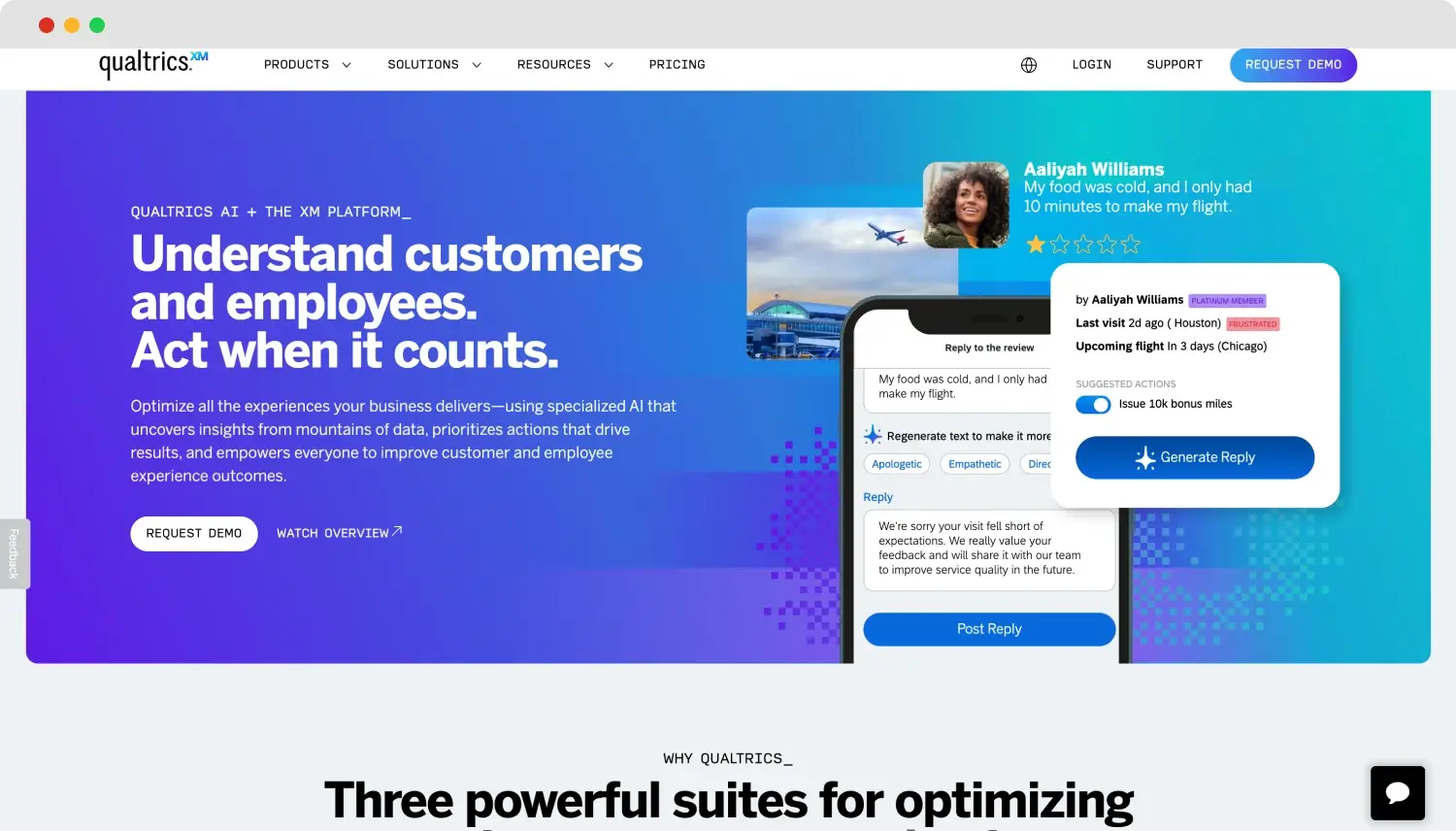
La página de inicio de Qualtrics
Qualtrics es una plataforma de software especialmente diseñada para construir y analizar encuestas en línea de alta calidad. Con su interfaz sencilla y robustas herramientas de análisis de datos, es ideal para llevar a cabo investigaciones diversas y recopilar comentarios para diversos propósitos. Sus impresionantes capacidades de inteligencia artificial mejoran aún más las experiencias de los empleados y clientes, lo que la convierte en una excelente solución para las necesidades de investigación de mercado y recursos humanos.
Google Forms vs. Qualtrics: 7 puntos esenciales
Hemos proporcionado una visión general de Google Forms y Qualtrics, pero para tomar una decisión bien informada, esto no es suficiente. Es crucial explorar las características de cada herramienta paso a paso. A continuación, encontrará una comparación detallada de 7 pasos que cubre planes y pruebas gratuitas, características específicas, plantillas de formularios, capacidades de personalización, y más.
1. Precios
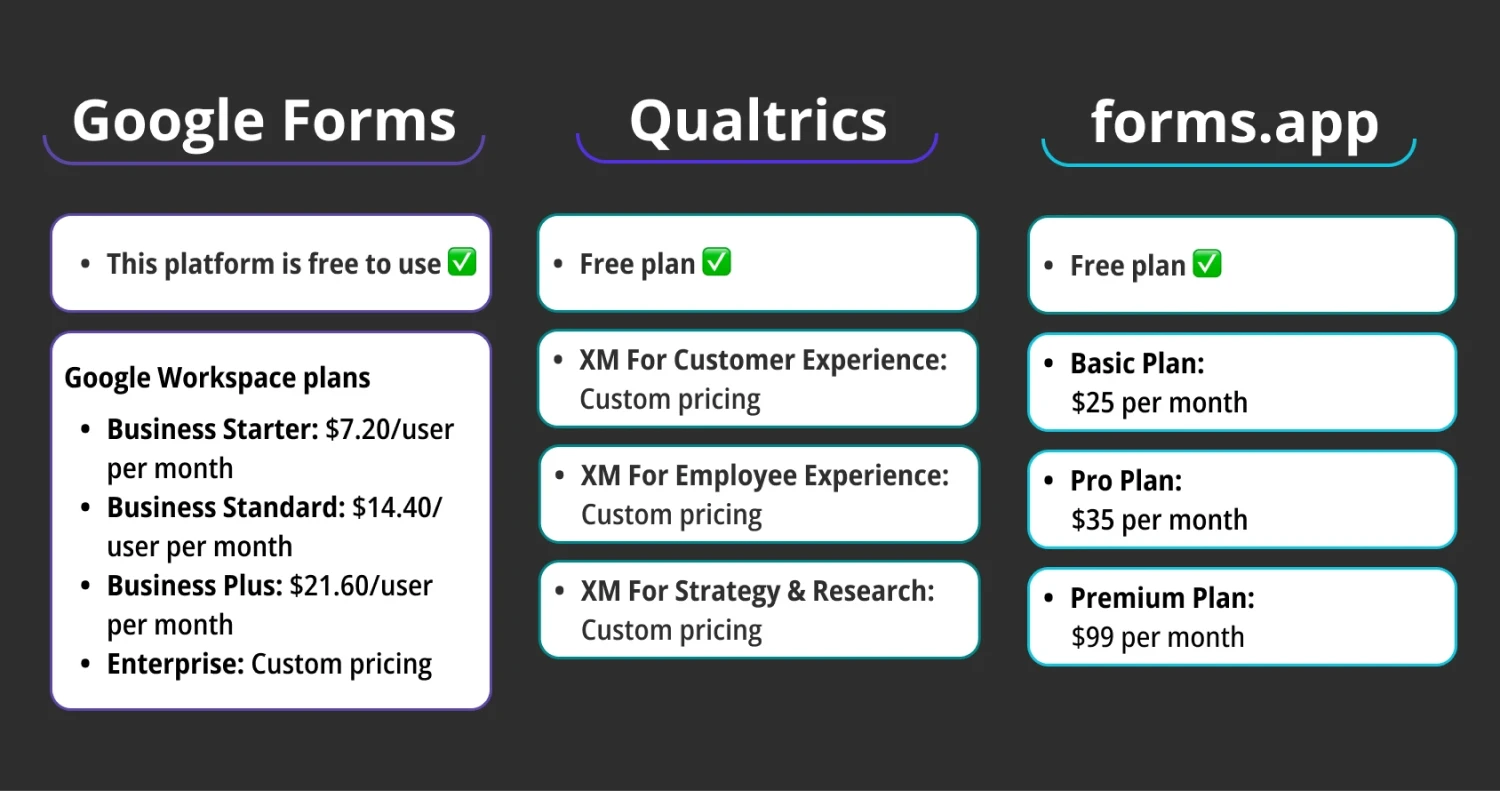
Comparación de precios entre Google Forms, Qualtrics y forms.app
Google Forms es gratis para usar, lo cual es una gran ventaja; todo lo que necesita es una cuenta de Google. Sin embargo, los usuarios empresariales pueden querer registrarse en Google Workspace para mejorar sus flujos de trabajo y acceder a aplicaciones adicionales. Este plan todo en uno incluye Google Forms, junto con otras herramientas como Gmail, Google Drive, y Google Sheets. Considere revisar los planes de precios de Google Forms:
Esta plataforma es gratis para usar✅
Planes de Google Workspace
- Starter Empresarial: $7.20/usuario por mes
- Estándar Empresarial: $14.40/usuario por mes
- Plus Empresarial: $21.60/usuario por mes
- Empresa: Precios personalizados
Qualtrics también tiene un modelo de suscripción, pero está diseñado para empresas con presupuestos más grandes. La plataforma no lista precios en su sitio web. Qualtrics ofrece tres planes: CustomerXM para mejorar las experiencias de los clientes, EmployeeXM para las necesidades de recursos humanos, y Estrategia e Investigación. A pesar de ellos, puedes crear una cuenta gratuita para usar el constructor de encuestas. Aquí están los planes de precios de Qualtrics:
- Plan gratuito ✅
- XM para la experiencia del cliente: precio personalizado
- XM para la experiencia del empleado: precio personalizado
- XM para estrategia e investigación: precio personalizado
Hablando de alternativas, forms.app tiene planes de precios transparentes y fácilmente accesibles que son sorprendentemente asequibles. Ofrece un plan gratuito que proporciona acceso a todas las funciones, plantillas de formularios, y campos. Los planes de pago de la plataforma comienzan en $25 al mes, lo que lo convierte en una opción perfecta para pequeñas empresas y uso personal. Considera revisar todas sus soluciones de precios:
- Plan gratuito ✅
- Plan básico: $25 por mes
- Plan Pro: $35 por mes
- Plan Premium: $99 por mes
2. Características del formulario
Google Forms cuenta con un constructor de arrastrar y soltar fácil de usar y una variedad de tipos de preguntas predefinidos, lo que hace que la creación de formularios sea rápida y sencilla. Los resultados se pueden exportar a Google Sheets o descargar como archivos. Sin embargo, requiere una conexión a internet, lo que puede ser un problema sin un acceso confiable. Además, proporciona lógica condicional básica para guiar a tus encuestados a través de las encuestas.
En contraste, Qualtrics ofrece potentes funciones para crear y analizar encuestas complejas. El Directorio XM proporciona una gestión avanzada de encuestados y encuestas personalizadas, incluyendo herramientas de análisis estadístico. La Herramienta de Retroalimentación 360 grados admite una recolección efectiva de retroalimentación para el desarrollo organizacional y de empleados. Qualtrics puede ser ideal para empresas, investigadores académicos, y compañías que necesitan funciones detalladas de encuestas.
Mientras que Qualtrics se enfoca en encuestas y Google Forms solo proporciona características esenciales, optar por forms.app puede ser una opción inteligente. forms.app admite la creación de todo tipo de documentos web con herramientas de inteligencia artificial que te ayudan a crearlos en unos pocos clics. Además, puedes beneficiarte de sus opciones de Vista de Pasos y Vista de Lista, una sólida lógica condicional y una fácil recopilación de pagos.
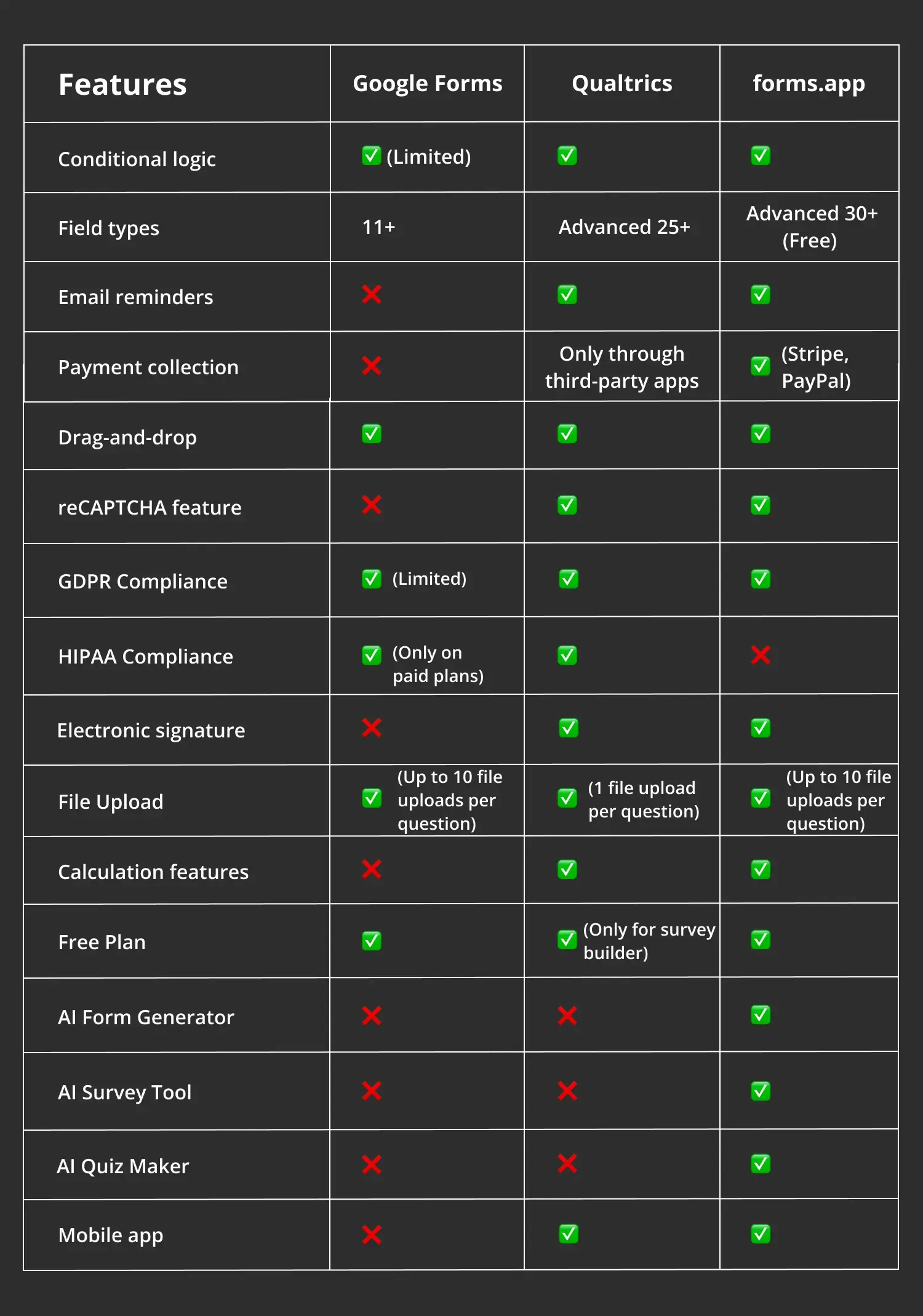
Comparación de características entre Google Forms, Qualtrics y forms.app
3. Opciones de personalización
Pasando a las capacidades de personalización, Google Forms nuevamente ofrece solo opciones básicas. Puedes personalizar tus formularios con fuentes adecuadas, imágenes personalizadas y temas de color para que coincidan con tu marca. Si bien la personalización se limita a diseños y tipos de preguntas estándar, es ideal para aquellos sin habilidades técnicas que necesitan crear formularios y documentos simples sin esfuerzo.
Qualtrics ofrece extensas opciones de personalización, incluyendo ajustar colores, fuentes yfondos como Google Forms. Además, Qualtrics te ayuda a elegir entre cuatro diferentes diseños de encuesta y limitar el número de preguntas por página. También eres libre de personalizar el texto del botón Siguiente y Atrás, agregar una barra de progreso, controlar el movimiento de la encuesta e incluso agregar CSS personalizado para posibilidades de tematización infinitas.
4. Tipos de campo
Google Forms presenta más de 11 tipos de campos, como respuesta larga, respuesta corta, opción múltiple, casillas de verificación y menús desplegables. Además, puedes incluir imágenes o videos, aunque el soporte de video está limitado a YouTube, que puedes agregar mediante búsqueda o enlace. Además, otras configuraciones para tus campos te ayudan a marcar opciones como descripción, validación de respuesta y cambiar el orden de las opciones.
Por otro lado, Qualtrics ofrece 22 tipos de preguntas principales para adaptarse a diferentes necesidades de investigación. Estos incluyen opciones de selección múltiple para encuestas simples, entrada de texto para respuestas abiertas y tablas de matriz para recopilar múltiples tipos de datos en una pregunta. Opciones avanzadas como controles deslizantes gráficos permiten una retroalimentación más interactiva. Tipos especializados como Mapa de calor y Punto caliente proporcionan información sobre las interacciones de sus encuestados.
forms.app es la mejor alternativa de Google Forms e incluso supera a Qualtrics en este paso. Ofrece numerosos campos esenciales y únicos adaptados para diversos propósitos, incluidas opciones innovadoras como Cesta de productos, Campo de dibujo y Campo de pago, con un total de más de 30 tipos de campos. Lo notable es que todas estas opciones están disponibles incluso con el plan gratuito.
5. Integraciones
Google Forms se integra sin esfuerzo con todo el Google Workspace y los productos Google Suite, mejorando la colaboración y los procesos de gestión de datos. Con un solo clic, puede vincular su formulario a una Hoja de cálculo de Google o guardar sus datos como archivos para usar en otras aplicaciones. Los usuarios de Google Workspace pueden conectar sus documentos, creando un flujo de trabajo fluido y fácil de trabajar.
Qualtrics ofrece amplias capacidades de integración con varias herramientas empresariales e investigativas, mejorando la utilidad de los datos y agilizando los flujos de trabajo. Se integra sin problemas con sistemas populares como Zendesk, HubSpot, y WorkJam, así como con plataformas de automatización como Zapier. Para reportes y análisis avanzados, Qualtrics se conecta con herramientas como Intuify, Five9, UserTesting, y Tableau.

Comparación de integración entre Google Forms, Qualtrics y forms.app
6. Colaboración en equipo
En cuanto a la colaboración en equipo, Google Forms tiene algunas características útiles que permiten la colaboración en tiempo real para múltiples usuarios en formularios. Puedes invitar a tus miembros de equipo a trabajar en tu documento, proporcionando acceso completo de edición para realizar cambios necesarios y recopilar respuestas. Por lo tanto, ya sea que trabajes solo o en equipo, Google Forms facilita la creación y gestión colaborativa de formularios.
Qualtrics también tiene herramientas de colaboración con las que puedes dar a otros usuarios de Qualtrics acceso a tus encuestas, asegurando un trabajo en equipo eficiente. Puedes restringir el acceso de los colaboradores, como permitir que los traductores trabajen sin acceder a los datos de la encuesta. La plataforma admite la colaboración tanto dentro como fuera de tu empresa y acomoda a nuevos usuarios. Sin embargo, estas características son más adecuadas para equipos profesionales.
7. Plantillas
El siguiente factor crítico es la biblioteca de plantillas. Google Forms te ofrece algunas plantillas esenciales para agilizar la creación de formularios. Proporciona plantillas predefinidas para diversas necesidades, como formularios de pedido, registro de eventos, solicitudes de trabajo, y comentarios de clientes, con temas y preguntas sugeridas. Aunque no tiene una extensa biblioteca de plantillas, las plantillas disponibles son útiles y fáciles de personalizar.
Una cuenta gratuita de Qualtrics te ofrece más de 50 plantillas gratuitas de encuestas. Estas plantillas cubren diversas necesidades, como Experiencia del cliente con encuestas de satisfacción y comentarios de clientes, Experiencia de marca con encuestas de conciencia de marca y prueba de logotipos, Experiencia del empleado con encuestas de compromiso de empleados, y Experiencia de producto con encuestas de características y precios. Estas plantillas te ayudan a recopilar información valiosa durante proyectos de investigación.
Google Forms ofrece una selección limitada de plantillas, mientras que Qualtrics se enfoca principalmente en la creación de encuestas. En contraste, forms.app se destaca por su amplia biblioteca de más de 5000 plantillas gratuitas. Estas plantillas se adaptan a la construcción de formularios, documentos, encuestas, cuestionarios, y preguntas, brindando opciones extensas para todas sus necesidades comerciales y personales. Además, están disponibles en varios idiomas.
Una mejor alternativa: forms.app
Después de nuestra comparación detallada, verá que aunque Google Forms es popular y fácil de usar, tiene algunas limitaciones. Qualtrics es altamente especializado, atendiendo solo a necesidades de investigación complejas con sus capacidades completas de creación de encuestas. Para una herramienta que sea sencilla para nuevos usuarios e incluya todas las funciones avanzadas en una sola aplicación, forms.app es una excelente opción para su negocio.
forms.app es un fuerte constructor de formularios en línea diseñado para empresas de todos los tamaños y propósitos. Puede crear formularios atractivos y efectivos, encuestas, y cuestionarios con él. Ya sea que su objetivo sea recopilar datos o simplificar procesos, su plataforma intuitiva es ideal. Además, las herramientas innovadoras de IA de forms.app seguramente captarán su interés. A continuación se presentan sus principales características:
📚 Fantástica biblioteca de plantillas: forms.app cuenta con más de 5000 plantillas, expertamente diseñadas para diversos campos y propósitos. Estas plantillas ofrecen soluciones listas para usar para todas sus necesidades de construcción de formularios, garantizando comodidad y eficiencia.
🤖 Funciones de IA: La plataforma incluye herramientas innovadoras impulsadas por IA como el Generador de formularios de IA, Herramienta de encuesta de IA, y Creador de cuestionarios de IA. Estas funciones aprovechan la tecnología de IA para ahorrarle tiempo y esfuerzo valiosos.
✨ Fácil de usar: Diseñado para principiantes y expertos, el editor de formularios de arrastrar y soltar de forms.app simplifica la creación de formularios, proporcionando resultados profesionales con facilidad.
🧩 Integraciones de terceros: forms.app se integra con aplicaciones populares como Slack, HubSpot, WordPress, Stripe, PayPal, y Google Drive. Estas conexiones rápidas mejoran la productividad y la eficiencia del flujo de trabajo de su equipo.
📲 Accesibilidad móvil: forms.app tiene una aplicación móvil dedicada disponible en Google Play Store y Apple Store, lo que asegura que pueda crear formularios sobre la marcha. Esta función le ayuda a mantenerse productivo en plataformas de escritorio y móviles.
Palabras finales
En resumen, es importante tener en cuenta que si bien tanto Google Forms como Qualtrics son herramientas ampliamente utilizadas, difieren no solo en sus propósitos previstos sino también en su complejidad. Google Forms es ideal para empresas más pequeñas y la creación rápida de formularios. Por otro lado, Qualtrics está diseñado para proyectos de investigación más grandes y necesidades de creación de encuestas más avanzadas.
Después de comparar estas dos plataformas, es difícil decir cuál es más fuerte o mejor debido a sus diferencias distintivas. Sin embargo, elegir forms.app como su herramienta de creación de formularios podría ser su mejor decisión. Ofrece funciones avanzadas, es excepcionalmente fácil de usar, y sigue siendo muy asequible para empresas de cualquier tamaño, lo que lo hace perfecto para cualquier propósito o alcance empresarial.
forms.app, tu creador de formularios gratuito
- Vistas ilimitadas
- preguntas ilimitadas
- notificaciones ilimitadas

